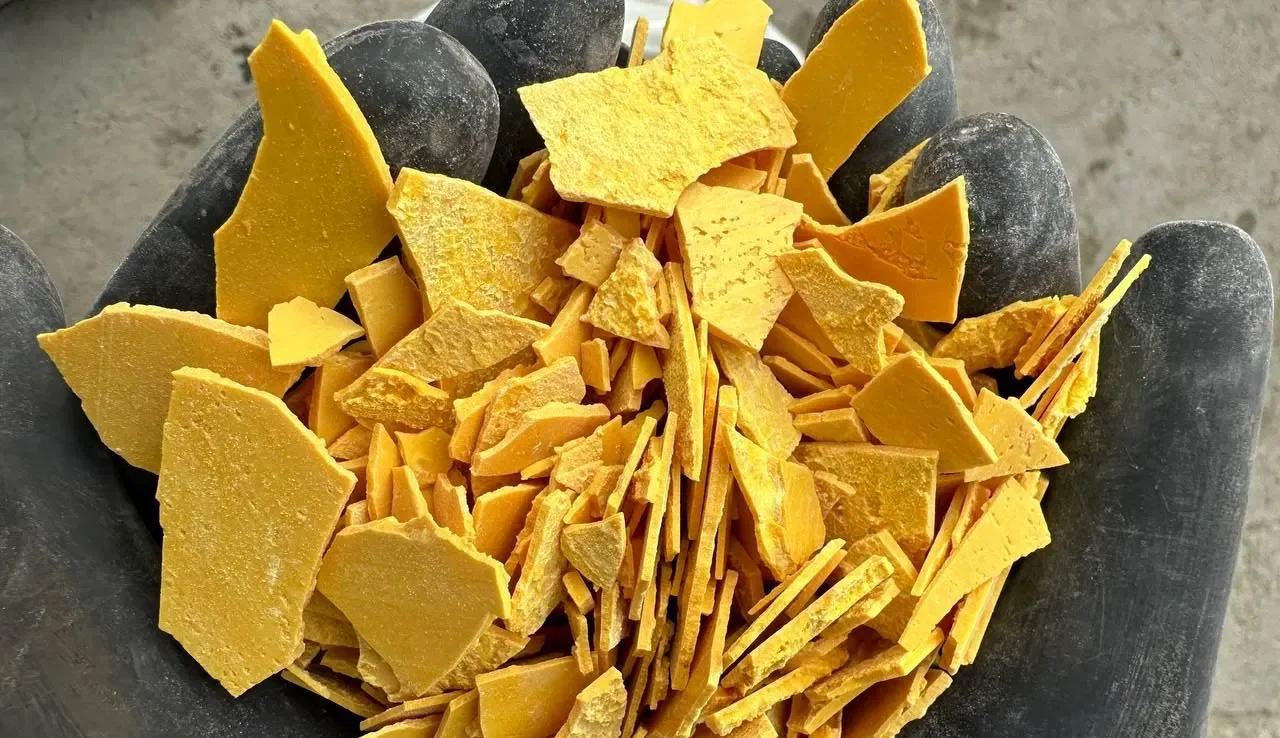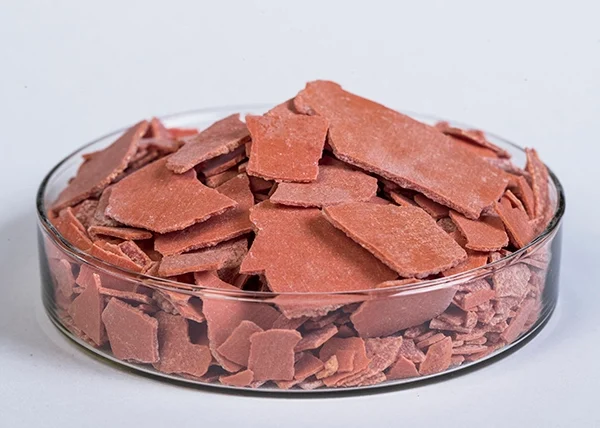 Sodium Sulfide Yellow Flakes
Sodium Sulfide Yellow Flakes
WHAT IS SODIUM SULFIDE?
Sodium sulfide is a chemical compound with the formula Na2S and its hydrated form with the formula Na2S.9H2O, both of which are water-soluble salts and produce strong and colorless alkaline solutions. Although sodium sulfide is a yellow solid, its solution is colorless. Sodium sulfide is produced in crystallized, cracked and broken forms and releases hydrogen sulfide gas when exposed to air, which smells like rotten eggs. Sodium sulfur reacts with hydrogen peroxide to produce sodium sulfate.
APPLICATION OF SODIUM SULFIDE
It is mainly used in textile, artificial silk and leather industries. Also in the paper industry, photography (coloring of black and white photos), oil recovery, paint and detergent manufacturing, rubber production, sulfur textile dyes, parasiticides, organic compounds preparation and water purification (as a metal precipitator) is used. Sodium sulfide with low iron content is preferred in applications where high purity is crucial and the presence of iron could negatively impact the process or final product quality.
HERE ARE SOME KEY APPLICATIONS:
- Chemical Synthesis: Sodium sulfide is used in the synthesis of fine chemicals and pharmaceuticals. Low iron content is essential to avoid contamination and ensure product purity.
- Photographic Industry: It is used in the manufacture of photographic developers and fixers. High purity with low iron content is necessary to prevent discoloration and maintain image quality.
- Dyes and Pigments: In the production of sulfur dyes and pigments, low iron content helps achieve consistent and desired color properties without contamination.
- Electronic Industry: Sodium sulfide is used in the manufacturing of electronic components and materials where even trace amounts of iron could affect the electrical properties and performance.
- Water Treatment: In applications such as the removal of heavy metals from wastewater, low iron content ensures that the treated water meets strict regulatory standards for purity.
- Textile Industry: For specific dyeing processes requiring high color fidelity and consistency, low iron content in sodium sulfide is critical to avoid any adverse effects on the dyeing process and final fabric quality.
- Rubber Industry: Sodium sulfide is used in rubber processing and vulcanization. Low iron content helps prevent any unwanted reactions that could affect the properties of the rubber.
- Food Industry: In the food industry, where sodium sulfide may be used in processing aids, low iron content is necessary to ensure compliance with food safety standards and to avoid contamination.
- Laboratory Reagent: As a reagent in various analytical and research applications, sodium sulfide with low iron content provides accuracy and reliability in experimental results.
- Cosmetic Industry: For use in certain cosmetic products, low iron content ensures that the final product is safe for use and free from impurities that could cause adverse skin reactions.
These applications highlight the importance of low iron content in sodium sulfide, ensuring high purity and preventing contamination in processes where quality and precision are paramount.
PRODUCTION OF SODIUM SULFIDE
In industry, sodium sulfide is obtained from the reduction of sodium sulfate with coal. These raw materials are found in abundance in nature. This reaction is carried out inside a furnace at a temperature of 1000 degrees Celsius. 0.5% of sodium carbonate is added to this reaction. This substance acts as both a catalyst and a neutralizing agent for any free acid. The product obtained from the furnace is known as black ash, which is cooled and crushed and washed several times by hot water. To prepare white crystals of sodium sulfide, 0.5% of sodium cyanide is added to the liquid before crystallization.
In the laboratory, it is prepared from the reaction of sulfur with sodium in anhydrous ammonia solution or with sodium in dry tetrahydrofuran with the catalyst of naphthalene. It is also obtained from the reaction of hydrogen sulfide and sodium hydroxide. In this method, sodium sulfide is produced in the form of flakes.
WHAT IS SODIUM SULFUR AND WHAT ARE ITS USES?
Sodium sulfide or sodium sulphide is a very strong reducing agent in various reactions. The density of sodium sulfur is 1.85 grams per cubic centimeter and it has various uses as a mineral salt. This chemical compound is among the compounds that are dangerous for the environment, for example, if this substance is left in water, it can be very harmful and harmful to aquatic organisms. Be sure to use protective equipment when working with this chemical.
Sodium sulfur is soluble in water and alcohol and reacts with oxygen. This chemical compound is in the hydrated form and when dissolved in water, it is colorless and produces a very strong alkaline solution. Sodium sulfur is produced in three forms: liquid, flakes and lumps in the chemical industry. For more information in this regard, follow us in the article in Raha Oil.
SOME OF THE MAIN USES ARE:
- It is used in heavy water of nuclear power plants.
- It is used as an additive for lubricating oils.
- It is used as an oxidation and reduction agent.
- It is used in surface preparation and plating.
- It is used as a separator of solid materials from waste water.
- Water purification, photographic chemicals and paper products are other uses of this material.
APPLICATIONS OF SODIUM SULFUR IN INDUSRIES
Sodium sulfide is obtained from the combination of two chemicals, sulfur dioxide and sodium carbonate. This chemical composition has many applications and is used in various industries such as the production and manufacture of cosmetics, car airbags, and household detergents. This chemical compound is also widely used in the production of cement and artificial silk. Other uses of this chemical are:
- This chemical compound is used in the production of industrial products as a preservative and in the food industry as an additive.
- Sodium sulfur is used in water and wastewater treatment to remove oxygen, chlorine and metal deposits.
- This chemical compound is used in photography to print black and white photos.
- This material is also used in the oil industry for oil extraction. This chemical composition prevents the corrosion of oil extraction equipment and machinery.
This chemical composition is widely used to produce powders and liquids for washing and cleaning clothes. This material plays a significant role in keeping the washing machine healthy. When iron is exposed to moisture and oxygen, it rusts and corrodes. Sodium sulfur in detergents, especially washing powders and liquid, reduces the oxygen in the washing water and most importantly prevents the rusting of the washing machine.
OTHER USES OF SODIUM SULFUR
- Sodium sulfur is also used in other industries, some of these industries are:
- Textile industry: In textile industry, this chemical compound is used for bleaching and separating sulfur and chlorine.
- Leather industries: In this industry, sodium sulfur is used for tanning animal skins. In such a way that the process of separating wool from animal skin is done with this substance.
- Dyeing industry: This chemical compound is used to stabilize and improve color.
- Chemical industry: Sodium sulfur is used in the process of sulfonation and sulfomethylation, production of rubber chemicals and sulfur dyes.
- Paper industry: In the paper industry, sodium sulfur is used in the form of flakes for the kraft process.
- Mining and metal extraction industries: This chemical compound plays a significant role in the mining and metal extraction industries and can separate stones from metals and cause mineral flotation.
- Food industry: this compound is used in a very small amount in the food industry as a preservative for packaged foods, such as juices, dried fruits, frozen shrimp and fish, canned vegetables and dried potatoes, gelatin, spices, A variety of ready-made soups, vinegar, packaged cereals and cooked and packaged foods are added.
WHAT IS SODIUM SULPHIDE Fe 30 PPM?
 Sodium Sulfide Fe 30PP
Sodium Sulfide Fe 30PP
Sodium sulfide Fe 30PP is a specific grade of sodium sulfide that contains a higher concentration of iron, typically around 30 parts per million (ppm). The “Fe” denotes the presence of iron, and “30PP” indicates the amount of iron in the sodium sulfide. This grade is used in industrial applications where the presence of iron does not adversely affect the process or final product.
KEY CHARACTERISTICS AND APPLICATIONS:
- Leather Tanning: Used in the dehairing process of hides and skins. The iron content does not significantly affect this application and is acceptable in the industry.
- Ore Flotation: Employed in the mining industry for ore flotation processes. The iron content can sometimes be beneficial in separating valuable minerals from their ores.
- Pulp and Paper Industry: Utilized in the kraft process for paper pulping. The iron concentration is manageable within the process and does not significantly impact the quality of the paper.
- Textile Industry: Applied in the dyeing process as a reducing agent. Depending on the dyeing requirements, the iron content might be acceptable or require management to ensure final product quality.
- Water Treatment: Used in the removal of heavy metals from wastewater through precipitation. The iron content can assist in the removal of other contaminants.
- Chemical Manufacturing: Used as an intermediate in the production of various chemicals. The iron content must be controlled based on the purity required for the end products.
- Oil Recovery: Utilized in enhanced oil recovery processes. The iron content is optimized based on specific recovery methods employed.
- Metallurgy: In metallurgical processes for ore processing and refining metals, the iron content can be beneficial in certain reactions.
IMPORTANCE OF IRON CONTENT
The iron content in sodium sulfide Fe 30PP must be considered in applications where high purity is essential. In these cases, even 30 ppm of iron can impact the process or product quality, necessitating careful selection based on the application’s specific requirements.
SUMMARY
Sodium sulfide Fe 30PP is a grade of sodium sulfide with an iron content of 30 ppm, suitable for various industrial applications where this level of iron is acceptable. It is crucial to match the grade with the application’s needs to ensure optimal performance and product quality.
RISK OF EXPOSURE
In case of contact with skin, eyes, swallowing and breathing, it is very dangerous. It is very corrosive in case of contact with eyes and skin. The amount of damage to the skin depends on the duration of exposure. In case of contact with the eyes, it causes damage to the cornea and skin. In case of skin contact, it causes blisters and skin swelling. Breathing its particles causes itching and sneezing. In case of continued exposure, it will cause nervous shock and eventually death. In case of contact with the eyes, it causes swelling, redness and watery eyes.
First Aid : In case of contact with the eyes, remove any contact lenses from the eyes and wash the eyes with cold water and keep the eyelids open and do not use any ointment. In case of penetration into the clothes, remove the clothes immediately. And be sure to wash your body with cold water. Use antiseptic and non-abrasive soaps and protect the skin with antibacterial creams.
PHYSICAL AND CHEMICAL PROPERTIES OF SODIUM SULFUR
This chemical compound is solid at a temperature of 33.4 degrees Celsius and melts at a temperature of 500 degrees Celsius. Due to its flammability, sodium sulfur should not be exposed to water, moisture, chemical and metal substances and must be stored in a dry and cool place, away from sunlight and in covered places. This combination is widely used in the leather industry, textile industry, separation of metals from minerals, artificial silk production, and paper production.
SODIUM SULFUR PRODUCTION METHODS IN CHEMICAL INDUSTRIES
This chemical compound is produced in three ways in the chemical industry, which are:
- Reduction of sodium sulfate with coal or gas
- Reaction of hydrogen sulfide and caustic soda.
- Electrolysis of table salt and combination of the resulting sodium alloy with sulfur
If sodium sulfur is exposed to moisture, it emits hydrogen sulfide, and when this happens, it produces a smell similar to rotten eggs. The presence of polysulfides in sodium sulfur causes its color to be yellow, but it becomes colorless when it becomes a solution. This chemical compound is also found in brick orange color.
THE FLAMMABILITY PROPERTY OF SODIUM SULFUR
Hydrogen sulphide is the only compound in this chemical that has flammability properties. Other compounds of sodium sulfur if exposed to high temperature; They are heated automatically and if there is enough moisture in the environment, these compounds will cool down by themselves. This action is called thermodynamic-kinetic.
CHEMICAL REACTIONS OF SODIUM SULFIDE
This chemical compound is very alkaline and incompatible with some acids. Generally, these compounds are used as reducing reagents. Also, this compound is not compatible with oxidizing compounds and reacts strongly.
Sodium sulfide and some other sulfides are not compatible with acids and show strong reactions and emit a gas called hydrogen sulfide. This gas is very dangerous and poisonous and is flammable. The mineral salt of this material is also flammable. If you put this material under high heat, it will decompose and eventually catch fire. The important thing is that if this material is stored in a dry environment without moisture, the intensity of the fire will increase.
The remarkable thing about this chemical compound is that it should not be exposed to heat and high temperature, otherwise it will turn into sodium oxide and sulfur oxide foam, both of which are highly toxic and harmful to the environment. They hurt. Sodium sulfur reacts strongly with carbon, diazonium salts, activated carbon and some other oxidizing substances, and people who use these substances in the production of their products must be very careful and provide safety measures for their employees.
DANGERS AND TOXICITY OF SODIUM SULFUR
This chemical compound is a strong base and may cause severe skin burns in people. A parameter called “dispersion coefficient” is another physical property of this chemical compound. This parameter measures the bioconcentration index of fat and the solubility of this compound in animal tissue.
Another danger of sodium sulfur is that if it enters the cell tissue of animals as a solution, it destroys and destroys fats and causes cell membrane corrosion in organisms. If a person accidentally swallows this chemical compound, severe poisoning and pain in the abdomen will occur, and this substance may also destroy the stomach and digestive system. Sodium sulfur is able to be absorbed by the body through breathing and cause risks such as shortness of breath and sore throat.
SODIUM SULFUR STORAGE CONDITIONS
This chemical substance should be stored in a dry, cool and covered place, and it should not be exposed to air, moisture, or sunlight, because if it is exposed to moisture and air, its performance will weaken and even its molecules will decompose. be. This composition has the ability to cause fire and reacts with water, moisture, chemical and metal substances.
SAFETY GUIDE FOR WORKING WITH SODIUM SULFUR
If this chemical comes into contact with your eyes or skin, you should immediately wash the area with plenty of water for 15 minutes. In case of inhalation of sodium sulphide, you should immediately move the person to a place with fresh air and if necessary, connect the person to an oxygen device. Finally, in case of more severe symptoms, take the person to medical centers.
You should keep this important point in mind about this chemical substance, that you must use appropriate protective and safety equipment when working with this substance.
Sodium sulfur is not classified as a dangerous chemical compound, but proper work clothes, gloves and glasses should be used when working with this chemical. You should be very careful in maintaining this chemical substance and you should not store this substance next to oxidizing compounds, organic solvents and flammable compounds. Also, keep in mind that whenever you use this chemical, close the lid of the container tightly, because this substance is very sensitive to moisture.
PACKAGING OF SODIUM SULFIDE
 Sodium sulfide packing
Sodium sulfide packing
Sodium sulfide is typically packed in several secure and standardized forms to ensure safe handling and transport. Common packaging options include:
- Jumbo Bags: Large bulk bags, often containing 1 ton to 1.25 ton of sodium sulfide.
- 25 kg Bags: Standard smaller packaging, often lined with polyethylene to avoid contamination.
Each packaging option is designed to prevent moisture contact and maintain the chemical’s quality.
TECHNICAL DATA SHEET OF SODIUM SULFIDE
SPECIFICATIONS RESULTS
Appearance Yellow Flakes
Na2S, % 60 ± 2
Na2SO3, % < 2
Na2CO3, % < 0.5
Fe, ppm < 10
Insoluble Contant, % < 12
Density, g/ cmᵌ 1600
Melting Point, ℃ 92
Fore more Information, and Placing order Please contact our Sales team.

